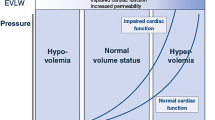Abstract
Two models of the cardiovascular system subjected to changes in intrathoracic pressure (ITP) are used to simulate the response to normal and positive pressure ventilation and the Mueller maneuver. The first model, based on our earlier model for cardiopulmonary resuscitation and cardiac assist by ITP variations, is based on lumped parameter representation of the cardiovascular system with two ventricles which function based on the time-varying elastance concept using their transmural pressures as the load. The ITP is assumed to be equally distributed in the thoracic cavity and equally affecting all cardiovascular structures within the chest. The model shows that a decrease in ITP is associated with an initial decrease in aortic pressure and flow and an increase in left ventricular end-diastolic and end-systolic volumes. A transient decrease in left ventricular volume which was suggested to occur by a few studies cannot be predicted based on this model. Such a decrease in left ventricular volume can be only predicted when a pericardial constraint is included, as done in the second model. Positive pressure interventions are associated with decreased heart volumes and cardiac output which is primarily a “preload” effect. In general the model reasonably predicts the hemodynamics as a function of the ITP changes and may be used as a tool to investigate the response of the cardiovascular system to various ITP interventions.
Similar content being viewed by others
References
Alexander, J. and K. Sagawa. Insensitivity of the left atrial and systolic pressure-volume relationship line to loading conditions.Circulation 68:supp III, 372, 1983 (Abstract).
Beyar, R., Y. Kishon, S. Sideman and U. Dinnar. Computer studies of systemic and regional blood flow mechanisms during cardiopulmonary resuscitation.Med. Biol. Eng. Comp. 22:499–506, 1984.
Beyar, R., S. Sideman and U. Dinnar. Cardiac assist by intrathoracic and abdominal pressure variations: A mathematical study of the cardiovascular system.Med. Biol. Eng. Comp. 22:507–515, 1984.
Cassidy, S.S., W.B. Wead, G.B. Seibert and M. Ramanathan. Interaction between the canine lung and left ventricle.Proc. 39th ACEMB, Baltimore, Maryland, p 72, 1986 (Abstract).
Cassidy, S.S., C.H. Robertson, A.K. Pierce and R.L. Johnson, Jr. Cardiovascular effects of positive end expiratory pressure in dogs.J. Appl. Physiol. 44:743–750, 1978.
Elzinga, G., R. van Grondelle, N. Westerhof and G.C. van der Bos. Ventricular interference.Am. J. Physiol. 226(4):941–947, 1974.
Fewell, J.E., C. Abendschein, C.J. Carlson, J.F. Murray and E. Rappoport. Continuous positive pressure ventilation decreases right and left ventricular end diastolic volumes in the dog.Circ. Res. 46:125–132, 1980.
Franklin, D.L., R.L. van Citters and R. Rushmer. Balance between right and left ventricular output.Circ. Res. 10:17–26, 1962.
Glantz, S.A., G.A. Misbach, W.Y. Moore, D.G. Mattey, J. Levken, D.F. Stowe, W.W. Parmley and J.V. Tyberg. The pericardium substantially affects the left ventricular diastolic pressure volume relationship in the dog.Circ. Res. 42:433–441, 1978.
Gorlin, R., J.H. Knowles and C.F. Stoney. The valsalva maneuver as a test of cardiac function: Pathologic physiology and clinical significance.Am. J. Med. 22:19, 1957.
Guyton, A.C., C.E. Jones and T.G. Coleman.Circulatory Physiology: Cardiac Output and Its Regulation. Philadelphia: W. B. Saunders, 1973.
Hoffman, J.E., A. Guz, A.A. Charlier and D.E. Wilken. Stroke volume in conscious dogs, effects of respiration posture, and vascular occlusion,J. Appl. Physiol. 20:865–877, 1965.
Hoffman, E.A. and E.L. Ritman. Invariant total heart volume in the intact thorax.Am. J. Physiol. 249:H883-H890, 1985.
Janicki, J.S., and K.T. Weber. The pericardium and ventricular interaction, distensibility, and function.Am. J. Physiol. 238:H494–H503, 1980.
Karam, M., R.A. Weis, T.K. Natarajan, S. Permutt and H.N. Wagner. Mechanism of decreased left ventricular stroke volume during inspiration in man.Circulation 69:866–873, 1984.
Lau, V.K., K. Sagawa and H. Suga. Instantaneous pressure volume relationship of right atrium during isovolumic contraction in canine heart.Am. J. Physiol. 236(5):H672–H679, 1979.
Maruyama, Y., K. Askikada, S. Isoyama, H. Kanatguka, E. In-Oka and T. Takishima. Mechanical interactions between four heart chambers with and without the pericardium in canine hearts.Circ. Res. 50:86–100, 1985.
Olsen, C.O., G.S. Tyson, G.W. Mayer, J.W. Davis and J.S. Rankin. Diminished stroke volume during inspiration: a reverse thoracic pump.Circulation 72:668–679, 1985.
Permutt, S. and R.L. Riley. Hemodynamics of Collapsible Vessels with Tone: The vascular waterfall.J. Appl. Physiol. 18:924–932, 1963.
Refsum, H., J. Junemann, M.W. Lipton, C. Skioldebrand, E. Carlsson and J.V. Tyberg. Ventricular diastolic pressure volume relations and the pericardium effects of changes in blood volume and pericardial effusion in dogs.Circulation 64:997–1004, 1981.
Robotham, J., W. Lixfield, L. Holland, D. MacGregor, A.C. Bryan and J. Rabson. Effects of respiration on cardiac performance.J. Appl. Physiol. 44:703–709, 1978.
Ruskin, J., R.J. Backe, J.C. Rembert and J.C. Greenfield. Pressure flow studies in man: Effect of respiration on left ventricular stroke volume.Circulation 48:79–85, 1973.
Sagawa, K., M.G. Midei, W.L. Maughan, R.Y. Oikawa and D.A. Kass. Ventricular contractility uneffected by ambient pressure.Proc. 39th ACEMB, Baltimore, Maryland, p 70, 1986 (Abstract)
Santamore, W.F., P.R. Lynch, G. Meir, J. Heckman and A.A. Bove. Myocardial interaction between the ventricles.J. Appl. Physiol. 41:362–368, 1976.
Shabetai, R., W.O. Fowler and M. Gueron. The effects of respiration on aortic pressure and flow.Am. Heart. J. 65:525–533, 1963.
Shirato, K., R. Shabetai, V. Bharugava, D. Franklin and J. Ross, Jr. Alternation of left ventricular diastolic pressure-segment length relationship produced by the pericardium.Circulation 57: 1191–1197, 1978.
Skotland O., U.U. Miller, T.S. Lekven and A. Ilebekk. The significance of the intact pericardium for cardiac performance in the dog.Circ. Res. 47:27–32, 1980.
Smiseth, O.A., M.A. Frais, I. Kingma, E.R. Smith and J.V. Tyberg. Assessment of pericardial constraint in dogs.Circulation 71:158–164, 1985.
Summer, W.B., S. Permutt, K. Sagawa, A.A. Shoukas and B. Bromberger Barnea. Effects of spontaneous respiration on canine left ventricular function.Circ. Res. 45:719–728, 1979.
Tyson, G.S., G.W. Mayer, C.O. Olsen, J.W. Davis and S.J. Rankin. Pericardial influences on ventricular filling in the conscious dog: An analysis based on pericardial pressure.Circ. Res. 54:173–184, 1984.
Author information
Authors and Affiliations
Rights and permissions
About this article
Cite this article
Beyar, R., Goldstein, Y. Model studies of the effects of the thoracic pressure on the circulation. Ann Biomed Eng 15, 373–383 (1987). https://doi.org/10.1007/BF02584291
Issue Date:
DOI: https://doi.org/10.1007/BF02584291




